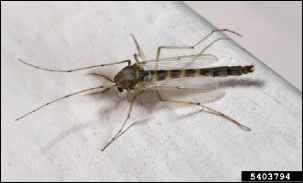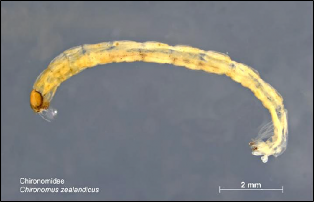Non-biting Midges
ID
ENTO-438NP
Introduction
Midges (Diptera: Chironomidae) are non-biting flies with numerous and often localized common names.
Description
Adult midges are delicate flies with long front legs often held forward from the body (Fig. 1). They measure 5-12.7 mm (0.2-0.5 inches) in length. They may range in color from light green, pale, tan, or dark brownish-black. The wings are clear and without markings. Adult midges are weak fliers and may congregate in large numbers on structures and vegetation near the water where they emerged.
Midges are frequently mistaken for mosquitoes, but they do not bite and do not transmit diseases. Male midges have bushy, feathery antennae (Fig. 1) while females have thread-like antennae. Adults may produce a high-pitched humming sound when swarming to attract mates.

Life Cycle
Midges have a complete life cycle consisting of an egg, larval, pupal, and adult stages. Midges breed chiefly in water, but some develop in decaying vegetation, manure, under the bark of trees, and additional sites where the substrate is highly saturated with water.
Larvae have thin-walled, segmented, worm-like bodies with a distinct head capsule. They live in the mud and sediment at the bottom of the water. They are often pale, greenish, or tan in color. The larvae of some species in low-oxygen habitats use hemoglobin to transport oxygen in their bodies. These are often called “blood worms” for their bright pink or red color. Because larvae can occur in huge numbers in water, they are an important source of food for many species of fish, birds, amphibians, and aquatic insects.

Adults emerge in the spring, sometimes in large numbers, but the peak usually lasts for only a few weeks. Birds and bats feed on adult midges. Adults are short lived, mating and dying over only a few days. Multiple generations are produced each year.
Damage
Although they do not bite, adult midges can be a severe nuisance simply by their presence in large numbers.
Habitat and Distribution
Adults frequently collect in large swarms in late afternoon or evening near streams, ponds, and lakes. They are often attracted to outdoor lights of houses close to these swarming sites. Immatures are found in both natural and man-made bodies of water such as ponds and lakes, reservoirs, streams and rivers, sewage treatment ponds, and stormwater management basins. They are tolerant of a wide range of oxygen and pollutant levels. However, large densities of certain midge species are associated with water with excessive levels of nutrients due to fertilizer run-off.
Control
Control of emerging midge adults is nearly impossible since bodies of water cannot and should not be treated with insecticides. Widespread outdoor fogging for adults is not practical as the insecticides available for this use are very short-lived and indiscriminate against many other benign insects.
Reduce outdoor lighting whenever possible to limit the attraction of adults that cluster on buildings at night. Lower intensity, motion-activated lights are a good choice if lights cannot be left off. Bright lights from indoors may also attract clustering adults. Lower shades or blinds at night during peak midge emergence periods. Doors and windows should be in good repair, with tight-fitting seals and screens without holes, to limit the entry of midges indoors.
Fertilizer run-off from residential lawns, managed turf, or agricultural fields may exacerbate midge populations. Consider nutrient management, such as reduced use of fertilizers or large buffers around water bodies, in areas with excessive midge populations.
Virginia Cooperative Extension materials are available for public use, reprint, or citation without further permission, provided the use includes credit to the author and to Virginia Cooperative Extension, Virginia Tech, and Virginia State University.
Virginia Cooperative Extension is a partnership of Virginia Tech, Virginia State University, the U.S. Department of Agriculture, and local governments. Its programs and employment are open to all, regardless of age, color, disability, sex (including pregnancy), gender, gender identity, gender expression, genetic information, ethnicity or national origin, political affiliation, race, religion, sexual orientation, or military status, or any other basis protected by law.
Publication Date
March 3, 2021


